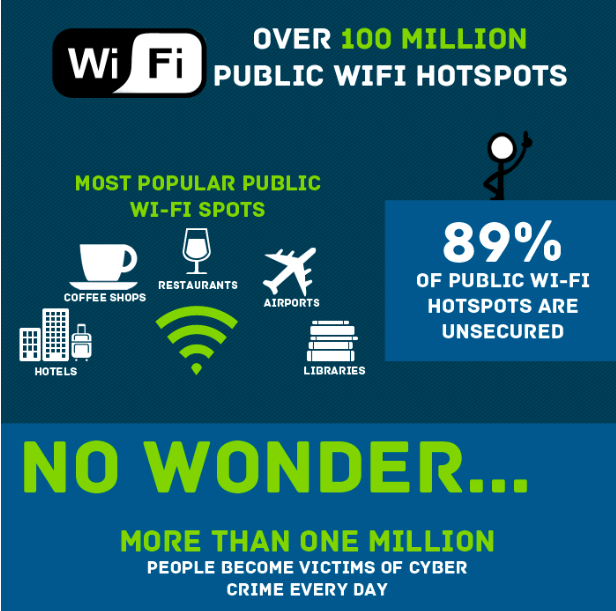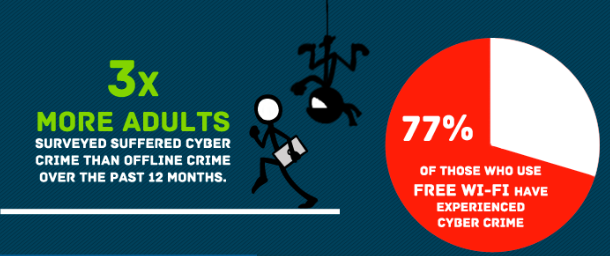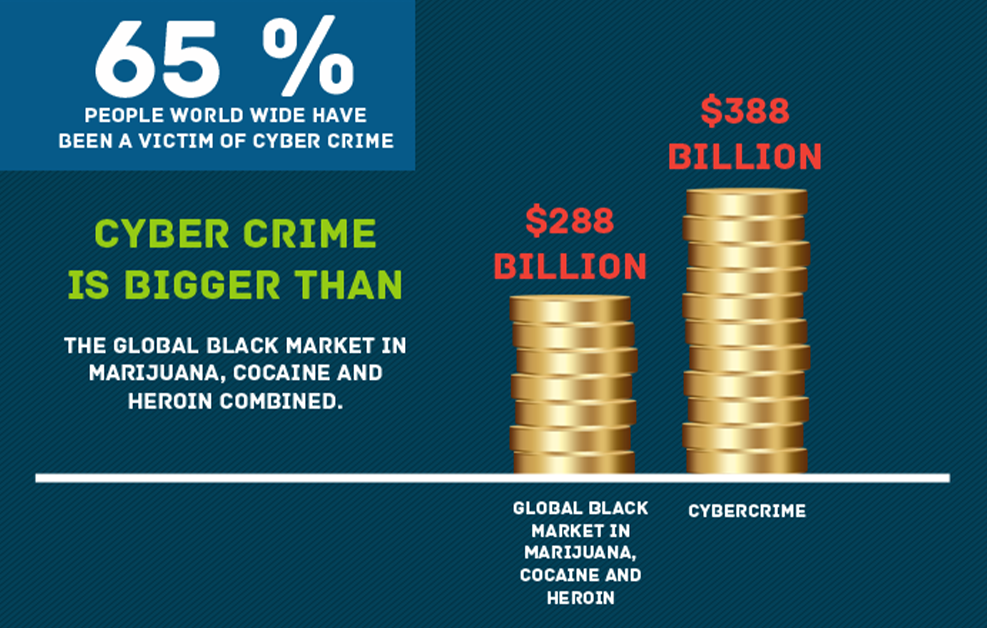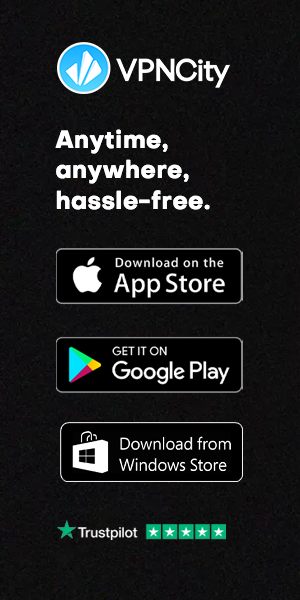We can all agree that free public WiFi is great, but how sure are you that it is safe?
Free public WiFi seems like the best thing since sliced bread.
Free, easy to use, decent speed, unlimited browsing.
What’s not to love?
A lot, actually. So let’s get started.
Free public WiFi hotspots can be a trap. They are open, unsecured and relatively easy to hack. They open up a whole new world of possibilities for hackers to invade your privacy, collect your personal and financial data, or even break into your device.
Eh.. Who would want to steal my data? It’s not that valuable …
Great question.
Well, as great as it is to sip on your avocado iced coffee in your local cafe while sending out invitations to your cat’s bar mitzvah — you know who else hangs out there? Your neighbour, the hacker. And he only leaves his mum’s basement for the public WiFi. Not because he needs it (his basement WiFi is much faster), but because the local cafe is where he finds his victims. Can you see where I’m going with this?
Hackers like to hang out on public WiFi just as much as you do, and it is clear to see why.

Public WiFis are full of security holes, and hackers know exactly what they are and how to take advantage of them. Outdated software, poor router configurations, and absence of (strong) passwords; leaves public hotspots vulnerable to malware. This is why it’s so easy for cybercriminals to slip viruses, ransomware, and even spyware onto your devices (all without you suspecting a thing).
Now you think I’m being paranoid, don’t you?
You’re absolutely right. It is kind of my thing.
But I have plenty of reasons to be, just keep reading and you will see.
Are public W-Fi hotspots really that easy to hack?
Yes. Anyone skilled enough to Google ‘how to hack someone through WiFi’, is skilled enough to hack a public WiFi hotspot.
Yes, anyone.
You are trying it right now, aren’t you?
Well… If even you could learn to do it — imagine what hackers can get access to. We’re talking all kinds of juicy, precious information such as credit card numbers, search history, calendar, and even your private conversations. And of course, there are all your passwords too (you’re making it easier for them by using ‘qwerty’ as a password for all your accounts, by the way).

So you’re trying to make me paranoid?
No … yes. Well, no. Look, whenever you connect to a public WiFi without any form of encryption, all your information is at risk.
Let’s say you’re staying at The Ritz and you connect to their WiFi. You think you are safe because, well it is posh and also password protected. But think again. Everyone else staying there knows that password too. The only thing stopping them from sharing the password with the world is whatever moral guidance their parents might or might not have given them growing up.
Do you see what I am trying to explain here? Public WiFis are a security nightmare. There couldn’t be an easier target for hackers than free unprotected WiFi hotspots: they are super easy to compromise and yet very few people think twice before connecting to them.
How do hackers exploit Public Wi-Fi?
There are so many ways I could be here telling you about them for days but I’m sure the guys at VPNCity would rather I finish my blog this week. So, here are the most popular ones that require minimum skills and effort.
- Evil Twin attack
In an Evil Twin attack, cybercriminals create a fake network with a name that is very similar to the actual legitimate wifi name. For example, if a coffee shop provides a wireless guest network named “CoffeeShop_Guest,” hackers will create a similar network of their own and call it “CoffeeShop_FREE.” Once connected to the evil twin, all your network traffic becomes visible to the hacker behind it. - Man-in-the-middle attack
In MITM attacks, hackers spy on your browsing activity, waiting for the perfect time to strike. To put it simply, the cybercriminal stands between your device and a website or service you are trying to access. From there, the hackers have the ability to intercept and alter all your communications and access sensitive information like banking credentials, passwords, cryptocurrency wallets, and even your private messages from auntie Doris begging you to stop sending her invites to play Candy Crush. - Malware injection
A malware attack is especially nasty and can occur when cybercriminals inject malware into unprotected WiFi hotspots and compromise your internet traffic. These attacks are extremely difficult to detect and a real pain to get rid of. On an unsecured WiFi network, malicious code can slip into your device at any time – when shopping for a new wine rack, or just browsing the Gram while sipping your morning avocado iced coffee. - Cookie side-jacking
Cookie side-jacking is one of the oldest forms of cyber-attack. When you are connected to an unsecured public WiFi, hackers can get their hands on your cookies. The same cookies that store your login details on your computer so you don’t have to enter your username and password every time you open a website. And stealing this information is easier than you think. - Nasty worms
While most people are usually familiar with viruses, not many people have heard of worms. The difference between the two is that the viruses require you to download a file, while worms can infiltrate your device, even if you don’t visit any shady sites. If a Wi-Fi network lacks proper security, worms can easily find their way to you and can compromise your data. - WiFi sniffing
With the help of pretty basic software, which is simple enough to use and legal to get, hackers can spy on your online activities, see your login information, steal your passwords and break into your online accounts if you’re browsing on an unsecured network. Somehow even creepier than sniffing stranger’s hair in public, and that’s a pretty low bar to set.

So how do I stay safe on public WiFi?
Now that I’m done trying to scare the pants off you, let’s talk solutions.
VPN.
Turn it on.
Seriously, that is all there is to it.
Go download one — preferably VPNCity — and turn it on whenever you can.
Really, you’ll love it. It encrypts your connection and hides everything you get up to on public WiFi, from your dodgy browsing activities, weird appointments (with Sparkle, a sexy single near you), embarrassing messages, lame passwords…
Every last bit of it.
You might be doing both yourself and the hackers a favour by keeping that a secret, really.
But how does it hide my information? Does that not mean you’ll be able to see it?
No. We don’t care what you do on the internet. As a matter of fact, we are passionately disinterested in ever finding out. Here’s how it works.
Contrary to what you may have heard, VPN is not rocket science. It is a virtual private network, which sends your Internet traffic through an encrypted tunnel, making it extremely difficult to intercept, track, or read. Once you have a VPN app installed on your device, all you have to do is connect to a VPN server (choose from all these), and you can browse on any wireless network without putting yourself at risk of becoming a cybercrime victim.
Simple, amIright? It is by far the most robust protection you can get to protect your privacy and stay secure on public WiFi at the same time.
Why should I care anyway?
You’ve never had your private information messed with, have you?
There’s nothing worse than calling some money-sucking helpline to report a dodgy activity on your account and being transferred from one person to another until you’re blue in the face.
Wouldn’t you just rather play it safe? Unless you’re the most careless thrill-seeker around, I mean. Then go ahead and enjoy the adrenaline rush of clicking scam links.
But the rest of us, we all need to protect ourselves with a VPN. With Public WiFi networks on nearly every corner, just imagine the sheer size of vulnerable devices.
It used to be just a good idea, but now it’s critical.
Without a good VPN to protect our information when browsing online, we are all just sitting ducks, waiting to be hacked.
So if you’re in the market for a VPN, here’s one you may enjoy. Personally recommended by me. It’s so good your life will never be the same. Seriously, get it now. For the price of a cup of coffee!
I’d say see you later but if I taught you one thing in this blog, I won’t be.



















